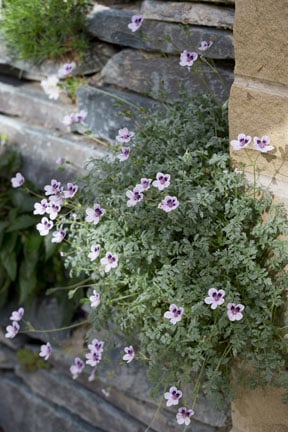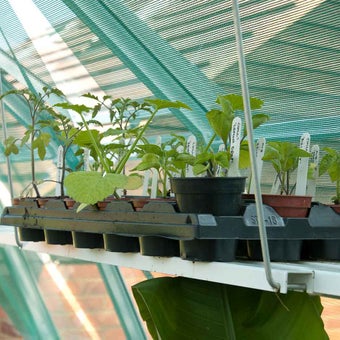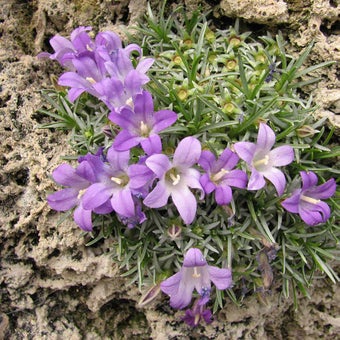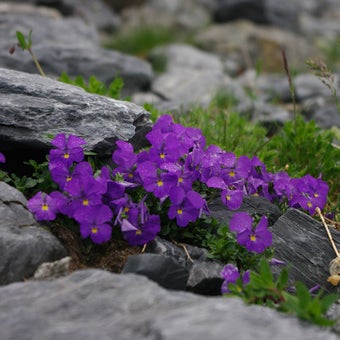
Quick facts
Suitable for: Alpines and plants that come from rocky parts of the world
Timing: Autumn/winter
Difficulty: Moderate
Suitable for...
A rock garden can provide several different habitats even in quite a small area. A rock, for example, can be placed so that sun-loving plants make the most of its sunny face whilst shade-tolerant plants can nestle in its north-facing shadow.
Alpines originate from high altitude regions above the 'tree line'. There is good drainage and usually cold, dry winters with high light levels. In gardening terms however, 'rock plants' embraces not just alpines but also includes smaller shrubs and that - because of their modest stature - look good in a rockery too. Gathering together plants with similar requirements and establishing them in a well-designed rock garden takes time and effort.
A large garden is not essential as it is possible to incorporate a rock garden into all sizes of plot. Specific features such as a dry stone wall and alpine sink or trough are particularly suitable for smaller gardens.
When to build a rock garden
Autumn and winter are good times to construct features as there is less to do in the garden. Spring is the optimum season to plant since an extensive range of plants are available at this time. Plants can then establish themselves for a before the challenge and enemy of rock plants – winter wet – arrives.
How to build a rock garden
Choosing the site
Whether you are able to devote a corner of your garden to creating a rock garden or you are planning to transform the whole back garden, it is worth considering the details of the microclimate.
- Aim to use the most open position, away from overhanging trees or tree roots, where plants will receive sun for the greater part of the day
- It is better to have fewer hours of sun per day than the whole day in light shade
- Choose a position where the drainage is perfect, unless you are prepared to build raised beds or enhance drainage in other ways
- Avoid frost pockets if possible
Preparation
Sketch a plan of the proposed rock garden, bearing in mind the gradient, any underground pipework, the amount of shade and how you might best view it.
Materials
Rock gardens are quite an investment in hard materials such as rock, stone, gravel or slate.
Choose local stone if possible. It will look in keeping with the surroundings and it is easier to go and choose the most suitable pieces from the quarry or landscape merchant.
- Buy salvaged or second-hand natural stone
- Sandstone is an example of a suitable rock, widely available, that is not too alkaline (limestone) or hard and dense (granite).
- Limestone from natural 'limestone pavements' was widely used. These pavements are a scarce and finite resource with a unique flora. They are now protected and quarrying prohibited
- Choose stone in a range of sizes so as to construct a natural looking outcrop
Building the rock garden
Construction of your rockery may seem rather daunting. For larger projects you will need the help of a professional landscaper, but smaller projects are quite feasible.
- Mark out the area using marker spray from a builders’ merchant or with dry pale sand poured from a bottle.
- Ensure that the area is weed-free, by hand weeding or other non-chemcial control methods
- Build a base 15cm (6in) deep of coarse rubble, broken bricks, stone, ballast or pea shingle
- To prevent the base layer from mixing with the , spread a layer of inverted turves over this, if available
- Alternatively, use a polythene sheet with holes punched at 10cm intervals, or permeable landscape fabric
Placing the stone
To create as natural a rock garden as possible;
- Select large stones to act as ‘keystones’. Position the larger of these first and place the remaining ones so that the strata look natural.
- Use a spade to dig out hollows to set the stone into.
- A crowbar will help move the stones into their permanent positions. Support them with smaller stones or bricks underneath.
- Aim for a naturalistic look when setting the rock in place. The rocks should tilt backwards, with the strata running the same way.
- Use weed-free top soil for the top layer of the rock garden, working it underneath and between the stones to set them firmly in place. Soil-based potting media such as peat-free John Innes No1 with added grit (up to 30% by volume) are weed, pest and disease free
- Bury the stones up to a third of their depth, firming them in place.
- Leave the areas between the stones unfirmed and add the specially made compost over the area to create planting pockets.
The basic planting mix should be;
- One part loam (ideally sterilised loam, but in a pinch garden soil can be used)
- One part horticultural grit
- One part leafmould or coir
This can be adjusted for individual plants’ requirements.
Planting the rock garden
Water the plants and place them in position while still in their pots. Allow for the plants’ height and spread when fully grown.
Remove the plant from the pot, tease out the roots slightly and remove any weeds from the surface of the compost. Make sure the plants are planted firmly in the compost mix and are top-dressed with gravel or grit.
For ideas on which alpine plants to use, please see our page on rock garden plants.
Crevice gardens
Crevice gardens have become popular in recent years. Sandstone slabs are set vertically into sand and infilled with more washed , grit or peat-free John Innes No1 potting media to which up to 30 percent by volume of grit is added.
The advantages are that the plants have a deep vertical root system, keeping them cooler in summer and warmer in winter, compared to growing in a more traditional rock garden setting. Moisture is used more efficiently in the microclimates made by the rocks forming the crevices.
The details of construction are best described in a publication ‘The Crevice Garden and its Plants’ by Zdenek Zvolanek (see below). Suitable plants for crevice gardens are listed on our web page on rock garden plants.
Problems
References
Books
A Guide to Rock Gardening by Richard Bird (Christopher Helm 1990, ISBN 9780747002277).
Rock Gardening (Royal Horticultural Society's Encyclopaedia of Practical Gardening) by Duncan Lowe (Reed Publishing 1996, ISBN 9781857327755).
The Crevice Garden and its Plants by Zdenek Zvolanek (Alpine Garden Society 2006, ISBN 9780900048784).
Societies










